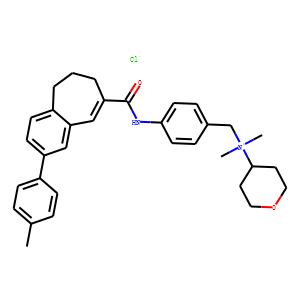| Reference | </br>1:CXCR3 antagonist VUF10085 binds to an intrahelical site distinct from that of the broad spectrum antagonist TAK-779. Nedjai B, Viney JM, Li H, Hull C, Anderson CA, Horie T, Horuk R, Vaidehi N, Pease JE.Br J Pharmacol. 2015 Apr;172(7):1822-33. doi: 10.1111/bph.13027. Epub 2015 Feb 10. PMID: 25425280 Free PMC Article</br>2:Diverse modifications of the 4-methylphenyl moiety of TAK-779 by late-stage Suzuki-Miyaura cross-coupling. Junker A, Schepmann D, Yamaguchi J, Itami K, Faust A, Kopka K, Wagner S, Wünsch B.Org Biomol Chem. 2014 Jan 7;12(1):177-86. doi: 10.1039/c3ob41873a. Epub 2013 Nov 12. PMID: 24217712 </br>3:Synthesis of thiophene-based TAK-779 analogues by C-H arylation. Junker A, Yamaguchi J, Itami K, Wünsch B.J Org Chem. 2013 Jun 7;78(11):5579-86. doi: 10.1021/jo400692p. Epub 2013 May 15. PMID: 23642160 </br>4:HIV-1 clade C envelopes obtained from late stage symptomatic Indian patients varied in their ability towards relative CD4 usages and sensitivity to CCR5 antagonist TAK-779. Gharu L, Ringe R, Bhattacharya J.Virus Res. 2011 Jun;158(1-2):216-24. doi: 10.1016/j.virusres.2011.04.003. Epub 2011 Apr 15. PMID: 21524671 </br>5:Effects of a calcineurin inhibitor, FK506, and a CCR5/CXCR3 antagonist, TAK-779, in a rat small intestinal transplantation model. Takama Y, Miyagawa S, Yamamoto A, Firdawes S, Ueno T, Ihara Y, Kondo A, Matsunami K, Otsuka H, Fukuzawa M.Transpl Immunol. 2011 Jul;25(1):49-55. doi: 10.1016/j.trim.2011.04.003. Epub 2011 Apr 15. PMID: 21515370 </br>6:The chemokine receptor antagonist, TAK-779, decreased experimental autoimmune encephalomyelitis by reducing inflammatory cell migration into the central nervous system, without affecting T cell function. Ni J, Zhu YN, Zhong XG, Ding Y, Hou LF, Tong XK, Tang W, Ono S, Yang YF, Zuo JP.Br J Pharmacol. 2009 Dec;158(8):2046-56. PMID: 20050195 Free PMC Article</br>7:Effects of blocking the chemokine receptors, CCR5 and CXCR3, With TAK-779 in a rat small intestinal transplantation model. Xu H, Firdawes S, Yamamoto A, Zhao Y, Ihara Y, Uehara S, Matsunami K, Otsuka H, Fukuzawa M, Miyagawa S.Transplantation. 2008 Dec 27;86(12):1810-7. doi: 10.1097/TP.0b013e31818fe7fe. PMID: 19104427 </br>8:HIV entry inhibitor TAK-779 attenuates atherogenesis in low-density lipoprotein receptor-deficient mice. van Wanrooij EJ, Happé H, Hauer AD, de Vos P, Imanishi T, Fujiwara H, van Berkel TJ, Kuiper J.Arterioscler Thromb Vasc Biol. 2005 Dec;25(12):2642-7. Epub 2005 Oct 20. PMID: 16239591 Free Article</br>9:Isolation of TAK-779-resistant HIV-1 from an R5 HIV-1 GP120 V3 loop library. Yusa K, Maeda Y, Fujioka A, Monde K, Harada S.J Biol Chem. 2005 Aug 26;280(34):30083-90. Epub 2005 Jun 27. PMID: 15983047 Free Article</br>10:TAK-779, a nonpeptide CC chemokine receptor antagonist, protects the brain against focal cerebral ischemia in mice. Takami S, Minami M, Katayama T, Nagata I, Namura S, Satoh M.J Cereb Blood Flow Metab. 2002 Jul;22(7):780-4. PMID: 12142563
|

